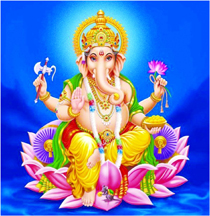
Vikata Sankasthi Chaturthi Vrat is an auspicious day amongst the Hindu community. The day is celebrated to offer prayers to Lord Ganesha, as on this day, Lord Shiva declares that his son is superior to other gods. The day is observed on the fourth day of Krishna Paksha. The word Sankasthi means to get rid of hurdles and evils. People observe a fast to get blessings from Lord Ganesha. Devotees take fruits, milk-based products, peanuts, sabudana khichdi, and potatoes.
This year, Vikata Sankashti Chaturthi falls on Sunday, April 9, 2023. The word Sankashti means deliverance and devotees believe that if they pray to Lord anapati on this day for a happy life, their wish will be granted. The puja is performed by offering Arghya (water) to the Moon God and then end their fast. As per the legends, Lord Shiva and Goddess Parvati decided to play Chausar but there was nobody to monitor the game. Hence, Lord Shiva produced a little boy and asked him to pose as the referee. The boy agreed. The Lord and his consort started playing the game. On the three consecutive occasions, Devi Parvati won the game, but the boy declared Lord Shiva the winner. Agitated by the boy’s biasness, she cursed him by saying that he would live in a swamp. Soon after getting punished, the boy pleaded for the mercy and apologised and said that he did it in ignorance.
After hearing boy’s plead, Goddess Parvati asked the boy to wait for the the Nag Kanyas and learn about the Sankashti Ganesh Chaturthi Vrat and told him to observe a vrat for 21 days to get rid of the curse. As suggested, he observed the fast and succeeded in pleasing Lord Ganesha. Meanwhile, Lord Shiva also observed fast for Devi Parvati to calm her down, who was upset with him. And Goddess Parvati too kept a fast, who wanted to meet her son Kartikeya. As a result, she returned to Kailasha (Lord Shiva’s abode) and Lord Kartrikeya to pay her visit. According to another legend, Ganesha was created by goddess Parvati, who is the wife of Lord Shiva. It is believed that Goddess Parvati created Ganesha out of turmeric paste and breathed life into the figure. She then set Lord Ganesha to guard her door while she took a bath.
When Lord Shiva returned, Ganesha did not know who he was and forbade him to enter. This enraged Lord Shjiva and asked his follower gods to teach the child some manners. Being born of Parvati, Ganesha was very powerful and defeated the godly followers as he guarded his mother while she bathed.
Later, Shiva severed the head of Ganesha. When goddess Parvati saw her son dead, she was filled with rage and vowed to destroy the universe where her son was killed. Shiva promised her that her son will live again. Lord Shiva found a mother elephant crying for her dead baby. He consoled the mother and fixed the head of the baby elephant in place of Ganesha’s head. Shiva declared that the boy would be called Ganesha and that he will be symbolised as the remover of all obstacles and supreme lord of intelligence.
In Sanskrit, Sankashti means to wipe out hurdles and evil. On Sankashti Chaturthi, people observe a strict fast in the honour of Lord Ganesha. Those who keep the fast, eat fruits, milk based projects, peanuts, sabudana khichdi and potatoes. The puja is performed in the evening after seeing the moon. A photo or idol of Lord Ganesha is decorated with fresh flowers, kumkum and durva grass. Then, an oil lamp is lit and devotees chant Ganapati mantras and read the vrat katha or the story of Sankashti Chaturthi. The fast is completed after seeing the moon and doing Ganapati puja. The Lord is offered with modak, durva, water in the bhog.
GANESHA: THE REMOVER OF OBSTACLES
Ganesha is one of the most distinctive Hindu deities with his large elephant head and pot-bellied human body. He plays a dual role of a supreme being powerful enough to remove obstacles and ensure success or create obstructions for those whose ambition has become destructive.
Ganesha is an archetype who you might call upon when you’re about to embark on a new endeavor. As the Remover of Obstacles and the god of success, Ganesha is honored throughout Indian and in Hindu cultures, at both secular and religious ceremonies. When someone launches a new business or moves into a new home, for example, the elephant-headed god is invoked to bless the venture.
Like other archetypes, Ganesha can be a source of inspiration or act as a role model as you try to achieve a goal. Archetypes are found everywhere, including in art, literature, and movies. Archetypes can be anyone who has traits you admire. In the Vedic tradition, they can play valuable roles in your relationships and spirituality as well as help shape your values and potential. Archetypes represent all of our collective soul’s yearnings, imagination, and deepest desires. And these themes have existed forever.
Revered for his cleverness and wisdom, Ganesha is also known as the patron of letters and learning. Ganesha is the scribe who wrote down the legendary Indian epic the Mahabharata, dictated to him by the ancient sage Vyasa, according to some scholars of Hindu literature. It is said that Ganesha agreed to transcribe the epic only if Vyasa would recite the poem without pausing.
In many depictions of Ganesha, he is shown holding a broken tusk in his lower right hand like a pen, perhaps symbolizing the sacrifice he made in feverishly writing the Mahabharata. Another interpretation of the broken tusk is that it’s a symbol of the truth that outward imperfections have nothing to do with inner perfection.




Be the first to comment